Publications of the 2009 ICS. Note the weight (in pounds) on the left side
of the picture.
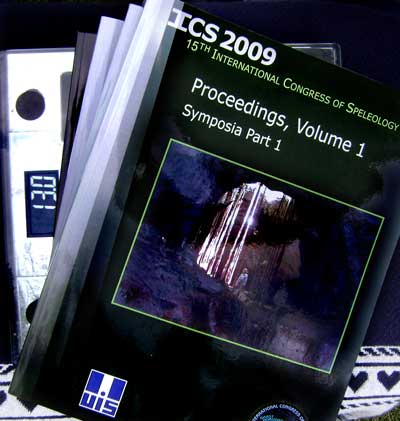
2009 International Congress of Speleology
A Saudicaves Report

|
One such procedure surprised a few U.S. participants at registration, when they
were handed the official congress nylon briefcase. “Is it full of bricks?” most
people asked when they hefted the 13-pound bag. Inside they found three thick
volumes of the Proceedings of the 15th Congress. Unlike some other organizations
which may publish their proceedings months or years after the event, the UIS
insists all papers be submitted far in advance of the congress. Efficient
indeed—and the Texas cavers did a bang-up job of printing all 2130 pages of this
opus.
|
 |
|
In an all-afternoon session on this new phenomenon, Dr. Hazel Barton of Northern Kentucky University explained that a cold-loving mold called Geomyces destructans—never before seen in the Americas—was somehow been introduced into caves in New York State, from which it has already spread all over New England, north to Canada and south to West Virginia.
|
 |
Apparently, the first photos of bats with white noses were taken in Howe Cave, New York, in February of 2006.This mold can grow all over the bodies of hibernating bats, giving them a cutaneous fungal disease whose presence is signaled by the white coating growing on their noses. It seems that the growth of this mold somehow awakens the sleeping bat again and again, forcing the animal to prematurely use up its fat reserves. The bat becomes emaciated and hungry and may even fly out of the cave in mid-winter in a futile attempt to find food. In the end, death comes from starvation and today one can find the floors of New England caves covered with bat carcasses..
WNS: An Ecological Disaster
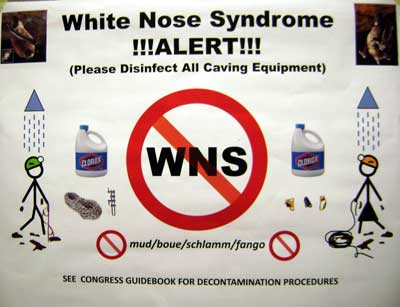 To make matters worse, researchers have found almost no evidence of resistance
to the disease in survivors. Gordon Birkhimer, president of the National
Speleological Society, called this “the most devastating wildlife tragedy to
confront us in our lifetime.” David Blehert at the U.S. Geological Survey
National Wildlife Health Center has called the results of this disease “an
ecological disaster” and Dr. George Veni, Executive Director of the National
Cave and Karst Institute, claims it represents “the largest decline in wildlife
species in one hundred years.” He points out that—because of the important role
played by bats in nature’s scheme—“White Nose Syndrome could lead to global
devastation of wildlife.”
To make matters worse, researchers have found almost no evidence of resistance
to the disease in survivors. Gordon Birkhimer, president of the National
Speleological Society, called this “the most devastating wildlife tragedy to
confront us in our lifetime.” David Blehert at the U.S. Geological Survey
National Wildlife Health Center has called the results of this disease “an
ecological disaster” and Dr. George Veni, Executive Director of the National
Cave and Karst Institute, claims it represents “the largest decline in wildlife
species in one hundred years.” He points out that—because of the important role
played by bats in nature’s scheme—“White Nose Syndrome could lead to global
devastation of wildlife.”
|
...All boots,
rope and gear had to be thoroughly scrubbed of mud and then submerged in a
bleach solution for ten minutes. Every item of clothing had to be washed using
the hottest water possible, and after that soaked in the same bleach solution
and finally air dried. This resulted in several sections of Schreiner University,
where the convention was held, becoming crisscrossed with sagging ropes
displaying everything from underwear to helmets, for passersby to admire all
through the congress...
|
 |
Caving in the Middle East
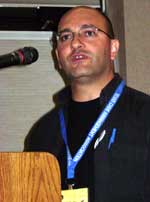
Caves of the Middle East were featured a number of times during the congress.
Fadi Nader, Secretary General of the International Union of Speleology,
described a visit to Iran by a team from Spéléo-Club du Liban in which Iranian
mountain climbers were trained in speleological exploration, rope and safety
techniques, resulting in an enthusiastic new caving group in Iran.
New discoveries of lava tubes in Jordan were presented by Stephan Kempe (who, of
course, referred to them as pyroducts).
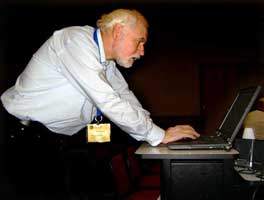 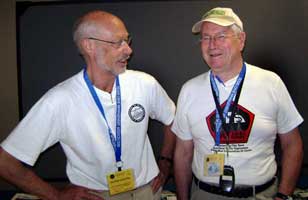 ¡
Stephan Kempe,
co-chair of the 2009 Lava Caves Symposium ¡
Stephan Kempe,
co-chair of the 2009 Lava Caves Symposium
¢ Jan Paul Van der Pas (on the left), chairman of the UIS Volcanic Caves Commission with Bill Halliday, founder of the commission and co-chair of the 2009 Symposium. |
Fadi Nader also described an exciting expedition to Syria in which a 1.6-kilometer-long pyroduct was surveyed in December of 2008, wresting the title of “longest lava tube on the Arabian Peninsula” from Saudi Arabia, which had only recently stolen it from Jordan. Clearly, Vulcanospeleology has taken off in the Middle East.
|
This was perhaps most dramatically demonstrated during John Pint’s presentations on three-million-year-old Umm Jirsan Cave and the potential for world-class caving in Saudi Arabia’s Khaybar Lava Field.
|
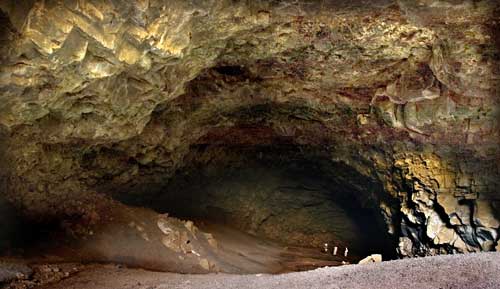 |
Saudi Arabia: Kilometers of Unexplored Caves
| Pint was part of the three-man Saudi Geological Survey team which
mapped
1.48-kilometer-long, 40-meter-wide, Umm Jirsan System in 2007, finding, among
other things, a human skull cap 4040 years old and a curious collection of
basalt scrapers, pointed instruments and sharpening stones.
|
 |
Pint pointed out that a geological survey of Harrat Khaybar indicates there are at least 40 other unexplored lava tubes in the area, ranging in length from one to possibly 50 kilometers. “There are many hundreds of kilometers of virgin cave out there,” says Pint, “and they are located in the cradle of civilization, where human beings have lived for the last 70,000 years.”
Congress presentations were held in nine different locations on the Schreiner
campus, necessitating fancy footwork for people attempting to catch all the
talks they were interested in. At the same time, bookstore and gear vendors,
non-stop video shows, “lightning” Powerpoints, etc. were all beckoning, not
to mention plenty of cave trips and bat-flight viewings.
Cave Photography at UIS 2009
A high point of the Congress was the Photo Salon, held at a
large, well-equipped theater in Kerrville. This featured digital “slides,” video
clips and prints...
| ...As
in past NSS conventions, the names of well-known U.S. cave photographers such as
Dave Bunnel and
Ann and Peter Bosted came up again and again, but this year they
were joined by Philippe Crochet
of France,
Tony Merino of Spain and
Gustavo Vela Turcott of Mexico, all of whom contributed outstanding images to the show.
|
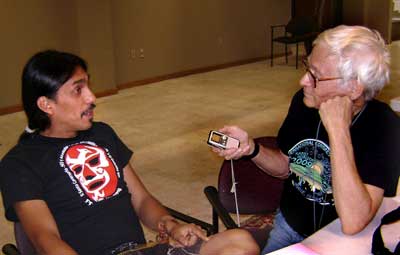 |
| The joint convention-congress ended with not one but two banquets on successive
nights, both held at a genuine, sprawling, Texas ranch, complete with longhorn
cattle and even horseshoe courts.
|
 |
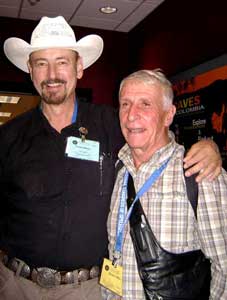  ¡
Frank Binney (the
man who arranged for the free Shiner beer at the congress) with Michel
Siffre, the French speleologist who spent long periods of isolation in
caves (including six months in a Texas cave) for scientific purposes. ¡
Frank Binney (the
man who arranged for the free Shiner beer at the congress) with Michel
Siffre, the French speleologist who spent long periods of isolation in
caves (including six months in a Texas cave) for scientific purposes.¢ Emily Davis of Speleobooks racing down a corridor faster than a speeding bullet. |
 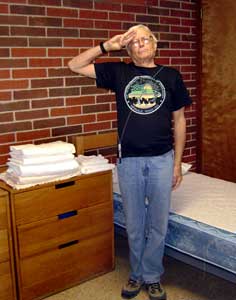 ¡ One of many 11mm clotheslines which decorated Schreiner University during the 15th UIS Congress. ¢ John Pint awaiting inspection at one of the college dorms, at the end of the congress. "I might have been tempted to steal one of the college's paper-thin blankets," says Pint, "to use as a hankie, but, of course, I preferred to get my $50 deposit back." |
|
Was this congress fun? Just ask Paolo Forti (right), who, by the way, presented a spectacular show on the mind-boggling giant crystals of Naica Cave in Mexico.
|